Global and China Automotive Operating System (OS) Industry Report,2022
Operating system research: the automotive operating system for software and hardware cooperation enters the fast lane.
Basic operating system: foreign providers refine and burnish functions; Chinese providers expand software and hardware cooperation.
Internationally, Blackberry's QNX, Linux-based custom operating system, and Android open source project-based operating system are still the three major basic operating systems. In 2022, centering on the benefits of their own products, the three major providers, Blackberry, Intel & Linux Foundation, and Google, play to their strengths, and vigorously expand ecosystem cooperation with OEMs in more aspects: QNX works hard on software and hardware hybrid high-performance computing platforms to facilitate development of "software-defined vehicles"; Intel & Linux Foundation, and Google expanded the cooperation with Chinese and European OEMs, respectively.
In China, Alibaba's AliOS and Huawei's HarmonyOS focusing on autonomous driving and intelligent cockpit, separately, upgrade underlying operating systems ecologically, and join hands with hardware suppliers to create cooperative software-hardware platforms and launch smart mobilOity system solutions.
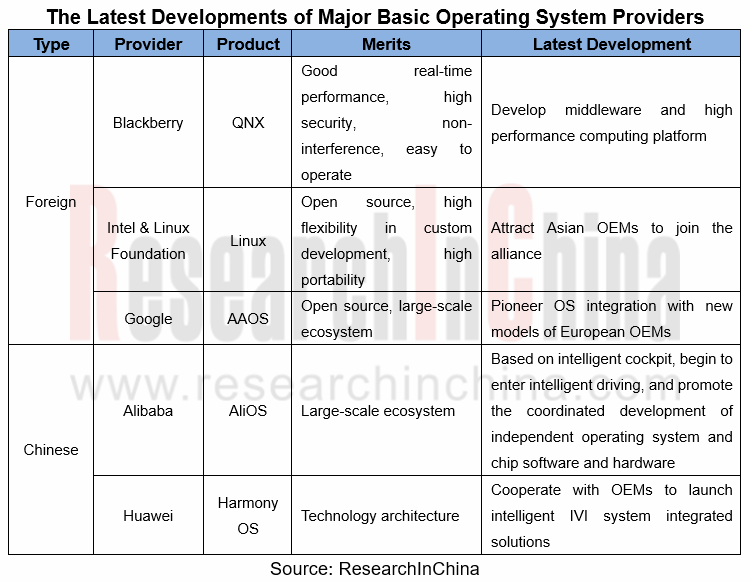
General operating system: Chinese providers develop diversified functions and create "system + hardware" ecosystems.
In China, the general operating system is oriented to infotainment and intelligent cockpit, and highlights the abundance of ecological resources, and the diversity of services and applications, meeting the individual needs of users, and building ecosystems. Most Chinese general operating systems are developed on Android. The 10 key Chinese providers in this report start with intelligent scene perception and intelligent cockpit, and team up with hardware suppliers to introduce system solutions of "domestic operating system + domestic chip". They also promote custom development of tools such as SDK and software computing platforms, allowing for secondary development in the fields of intelligent cockpit and autonomous driving, and creating diversified, customized and ecological comprehensive operating system solutions.
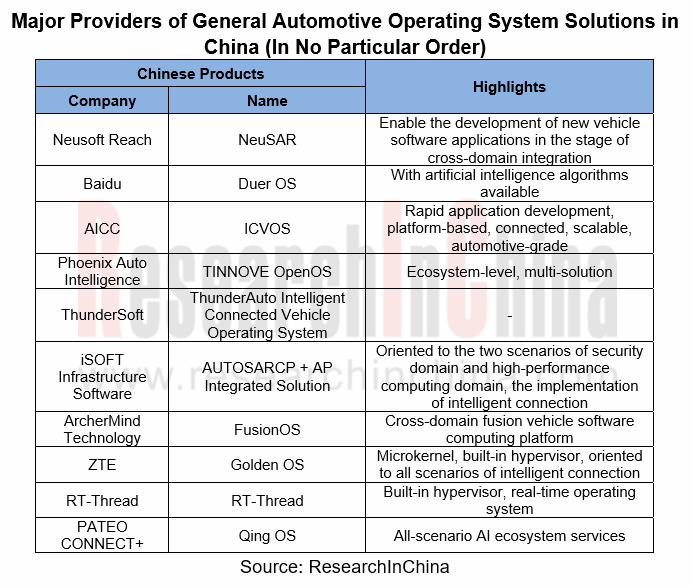
Neusoft NeuSAR
To solve the problem that the conventional development models can no longer meet the market’s requirements for vehicle development speed and functional iteration, Neusoft Reach introduced NeuSAR4.0 in December 2022, aiming to build an industry ecosystem.
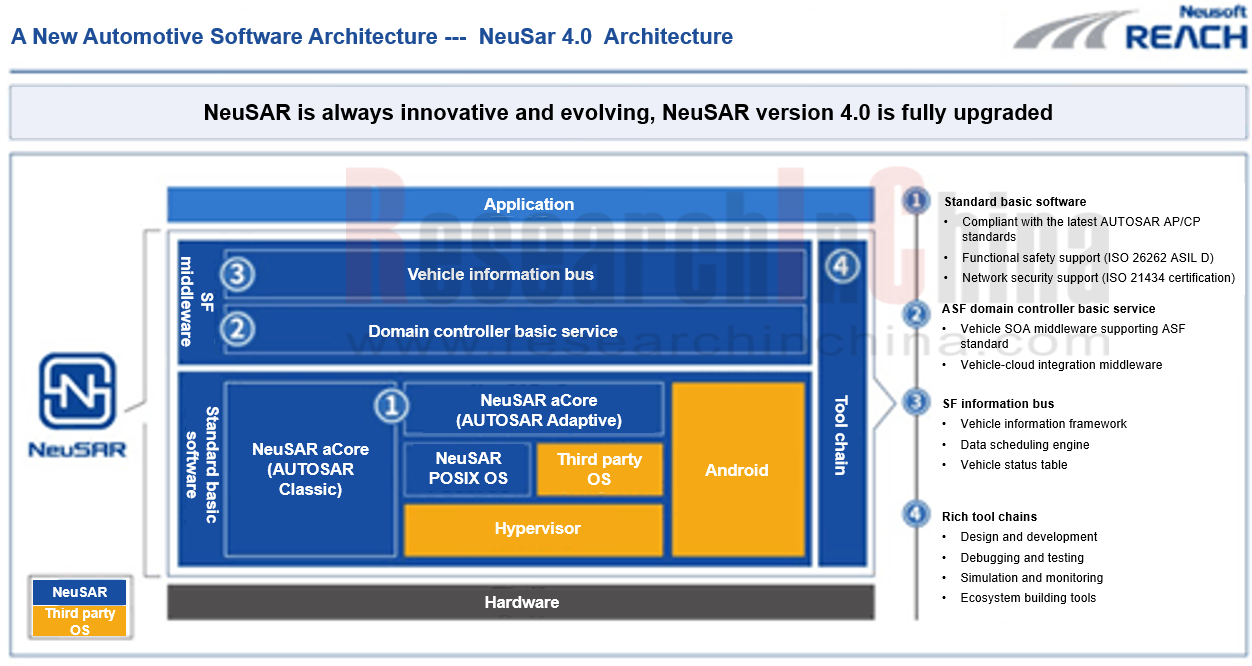
The NeuSAR4.0 upgrades the NeuSAR SF service framework, with advantages in four aspects: the further decoupling of application development software and hardware enables dynamic migration of functions; the more efficient simulation and debugging functions achieves global synchronization of data; the flexible deployment of message channels meets the needs of different application scenarios; the "vehicle" and "cloud" connection allows for the integration of vehicle and cloud services.
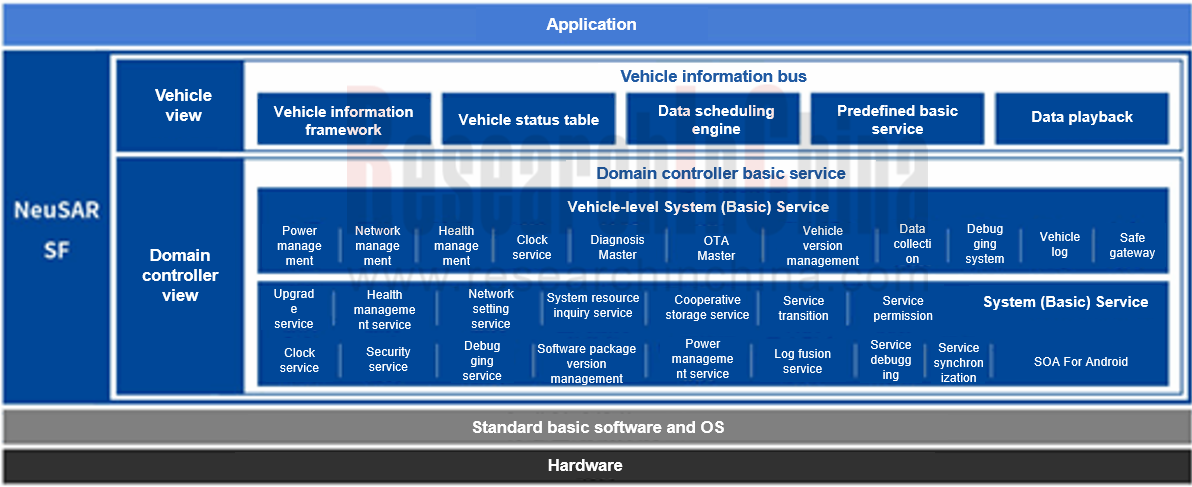
In addition, NeuSAR4.0 has upgraded the NeuSAR DevKit tool chain, covering NeuSAR Creator (IDE-like integrated development tool), NeuSAR Monitor and NeuSAR Simulator, which can realize the entire domain controller development process, and monitor some dynamic resources in the development process, and simulate the third-party devices that need to be used in the development process, respectively.
ArcherMind Fusion OS
Based on the cooperation with chip vendors like Qualcomm, Renesas, Nvidia, and NXP, ArcherMind launched a fully self-developed cross-domain integrated vehicle software computing platform FusionOS in 2022. As a general operating system middleware solution, it includes intelligent cockpit domain EX6.0, central control domain Fusion3.0, intelligent driving domain operating system solution FusionAD, and cross-domain fusion software operating system solution.
Fusion SOA software platform that covers the six solutions of middleware layer, service layer, operating system & hardware layer, cloud, tool chain, and service plug-in, provides full-stack SOA technical capabilities with mass production experience. It has been adapted to the latest cockpit platforms of multiple automotive-grade chip vendors like Qualcomm, Renesas and SemiDrive, and supports QNX, Android, Linux and other operating systems. It also provides a fully optimized graphics system, AI Orchestra Engine middleware and the latest voice algorithm engine AM Acoustic Engine.
RT-Thread "Cheng Xuan" Vehicle Fusion Software Platform
In 2022, RT-Thread announced the RT-Thread "Cheng Xuan" Vehicle Fusion Software Platform, an embedded real-time operating system composed of kernel, network, file system, and GUI components.
Based on virtualization system vmRT-Thread Hypervisor, Cheng Xuan Vehicle Fusion Software Platform carries the safe real-time system RT-Thread Secure Auto, the microkernel operating system RT-Thread Smart Auto, and Linux or other systems, and can be compatible with multiple system platforms, making it easy to use. It enables information interaction via unified distributed message bus and upper module.
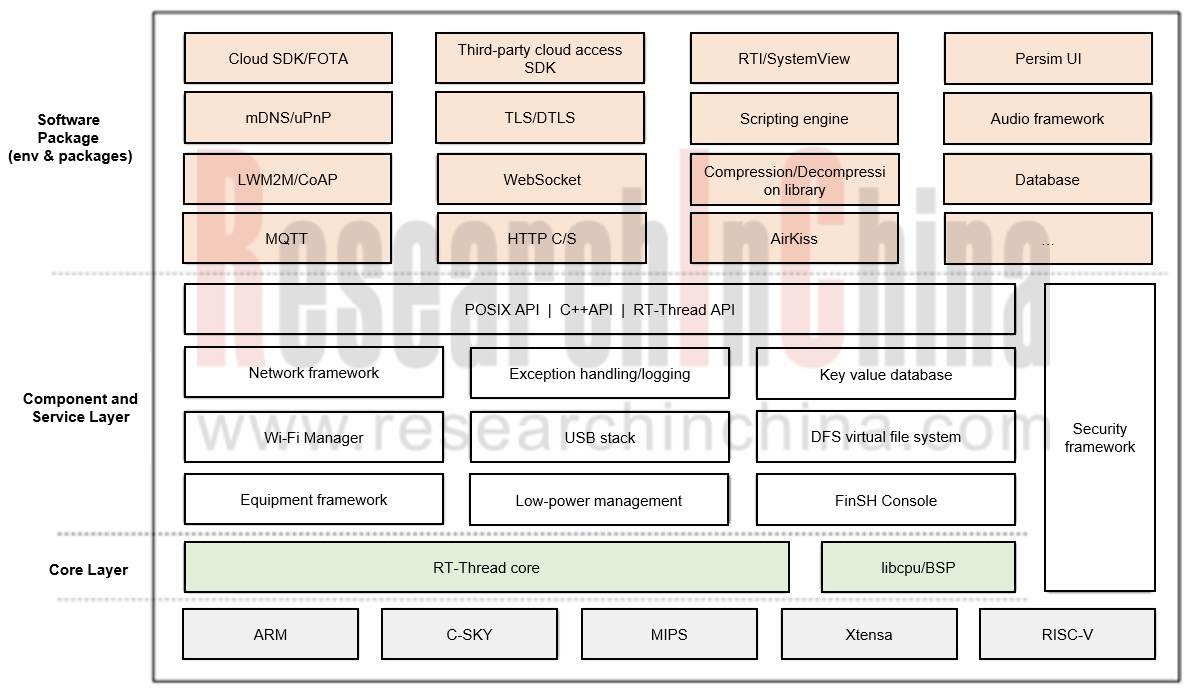
Hypervisor: foreign leading established providers boast much greater first-mover advantages, and Chinese players go all out to catch up.
In the global hypervisor market, automotive standard-compliant, mass-produced hypervisor products include Blackberry QNX Hypervisor, Wind River Vxworks, OpenSynergy COQOS, and Linux Foundation’s ACRN. In the field of automotive virtual layer in China, there are a growing number of companies independently developing hypervisor, for example, the likes of Banma Zhixing, iSOFT Infrastructure Software, Zlingsmart and ZTE all have technical strength of virtualization, but still lag far behind their foreign peers. The basic hypervisor type is Type-1, and Zlingsmart has realized mass production of its RAITE Hypervisor.
In 2022, foreign hypervisor providers concentrated on fostering partnerships with OEMs in smart mobility scenarios. For example, while maintaining its share in the market, QNX Hypervisor worked to expand application cooperation with such companies as Neta Auto and MarelliTech in driving and cockpit scenarios; OpenSynergy built hypervisor technology cooperation with Qualcomm Snapdragon Automotive Development Platform (ADP) and STMicroelectronics.
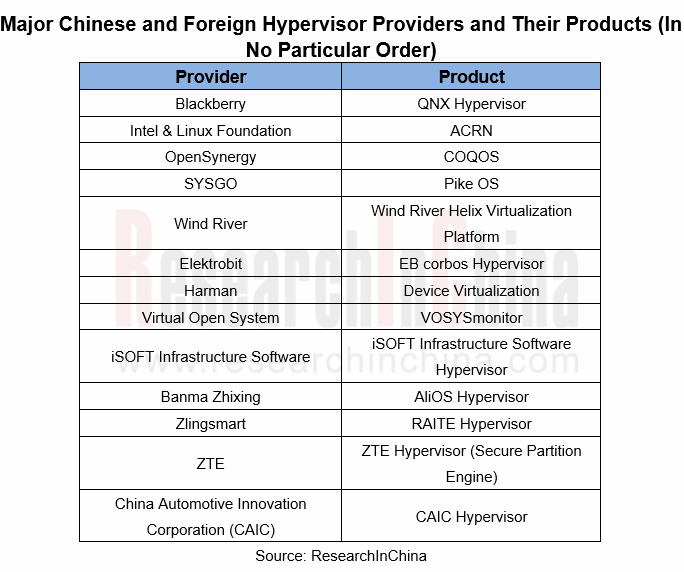
IVI mirroring system: build ecosystem barriers, and develop service ecosystems and interactive functions.
Apple Carplay, Google Android Auto, Baidu Carlife, and HUAWEI HiCar among others have established influence in IVI mirroring system market. These providers designate IVI mirroring systems for connecting their own brands, so as to pose a brand barrier. New entrants such as Xiaomi and Vivo are also vigorous in the market. Starting with IVI mirroring systems, they build an IoV ecosystem service system, and mainly offer the interactive perception and service connection functions of mirroring systems, which have yet to be used on large scale.
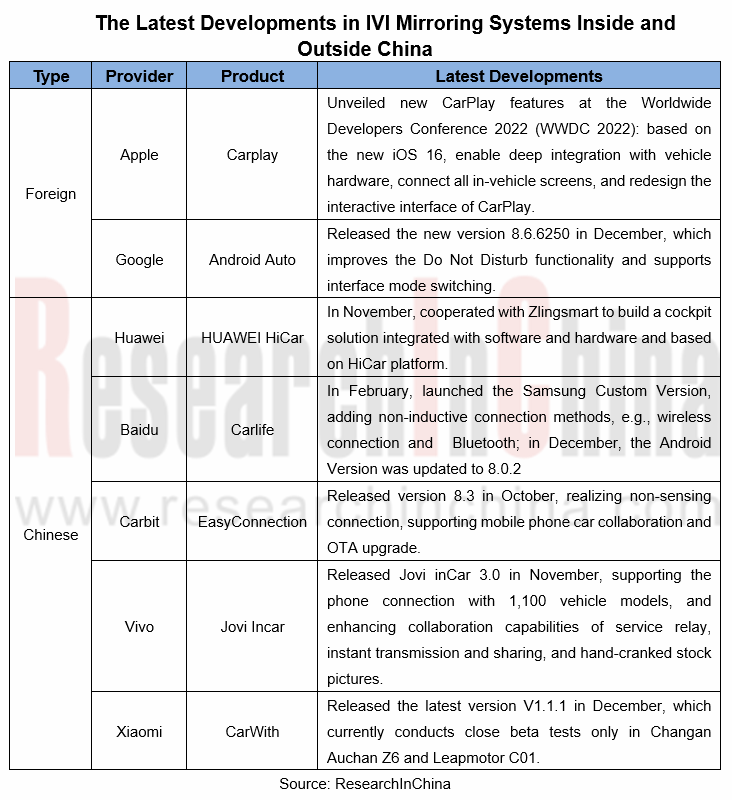
China Passenger Car Navigate on Autopilot (NOA) Industry Report, 2023
Intelligent driving is evolving from L2 to L2+ and L2++, and Navigate on Autopilot (NOA) has become a layout focus in the industry. How is NOA advancing at present? What are hotspots in the market? Wh...
Automotive Telematics Service Providers (TSP) and Application Services Research Report, 2023-2024
From January to September 2023, the penetration of telematics in passenger cars in China hit 77.6%, up 12.8 percentage points from the prior-year period. The rising penetration of telematics provides ...
Passenger Car Intelligent Chassis and Chassis Domain Controller Research Report, 2023
Passenger Car Intelligent Chassis and Chassis Domain Controller Research Report, 2023, released by ResearchInChina combs through three integration trends of brake-by-wire, steer-by-wire, and active su...
Automotive Smart Cockpit Design Trend Report, 2023
As the most intuitive window to experience automotive intelligent technology, intelligent cockpit is steadily moving towards the deep end of “intelligence”, and automakers have worked to deploy intell...
China Automotive Multimodal Interaction Development Research Report, 2023
China Automotive Multimodal Interaction Development Research Report, 2023 released by ResearchInChina combs through the interaction modes of mainstream cockpits, the application of interaction modes i...
Automotive Smart Surface Research Report, 2023
Market status: vehicle models with smart surfaces boom in 2023
From 2018 to 2023, there were an increasing number of models equipped with smart surfaces, up to 52,000 units in 2022 and 256,000 units ...
Passenger Car Intelligent Steering Industry Report, 2023
Passenger Car Intelligent Steering Industry Report, 2023 released by ResearchInChina combs through and studies the status quo of passenger car intelligent steering and the product layout of OEMs, supp...
Automotive High-precision Positioning Research Report, 2023-2024
Autonomous driving is rapidly advancing from highway NOA to urban NOA, and poses ever higher technical requirements for high-precision positioning, highlighting the following:
1. Higher accuracy: urb...
New Energy Vehicle Thermal Management System Research Report, 2023
Thermal management system research: the mass production of CO? heat pumps, integrated controllers and other innovative products accelerates
Thermal management of new energy vehicles coordinates the c...
Commercial Vehicle Intelligent Chassis Industry Report, 2023
Commercial Vehicle Intelligent Chassis Industry Report, 2023, released by ResearchInChina, combs through and researches status quo and related product layout of OEMs and suppliers, and predicts future...
Chinese Independent OEMs’ ADAS and Autonomous Driving Report, 2023
1. Wide adoption of NOA begins, and local brands grab market share.
According to ResearchInChina, from January to August 2023, joint venture brands accounted for 3.0% of installations of L2.5 and hi...
Passenger Car Radar Industry, 2022-2023
Passenger Car Radar Industry Research in 2023:?In 2023, over 20 million radars were installed, a year-on-year jump of 35%;?Driven by multiple factors such as driving-parking integration, NOA and L3, 5...
Automotive Audio System Industry Report, 2023
Technology development: personalized sound field technology iteration accelerates
From automotive radio to “host + amplifier + speaker + AVAS” mode, automotive audio system has passed through several...
China Intelligent Door Market Research Report, 2023
China Intelligent Door Market Research Report, 2023 released by ResearchInChina analyzes and studies the features, market status, OEMs’ layout, suppliers’ layout, and development trends of intelligent...
Automotive Infrared Night Vision System Research Report, 2023
According to the data from ResearchInChina, during 2022-2023, the installations of NVS (night vision system) in new passenger cars in China went up at first and then down. From January to July 2022, t...
New Energy Vehicle Electric Drive and Power Domain Industry Report, 2023
Electric drive and power domain research: electric drive assembly evolves to integration and domain control
To follow the development trend for electrified and lightweight vehicles, new energy vehic...
Automotive Software Business Models and Suppliers’ Layout Research Report, 2023
From the layout of automotive software products and solutions, it can be seen that intelligent vehicle software business models include IP, solutions and technical services, which are mainly charged i...
Automotive LiDAR Industry Report, 2023
In August 2021, Waymo discontinued its commercial LiDAR business.
In October 2022, Ibeo declared bankruptcy; in November, two listed companies, Velodyne and Ouster, confirmed their merger; and in Dec...